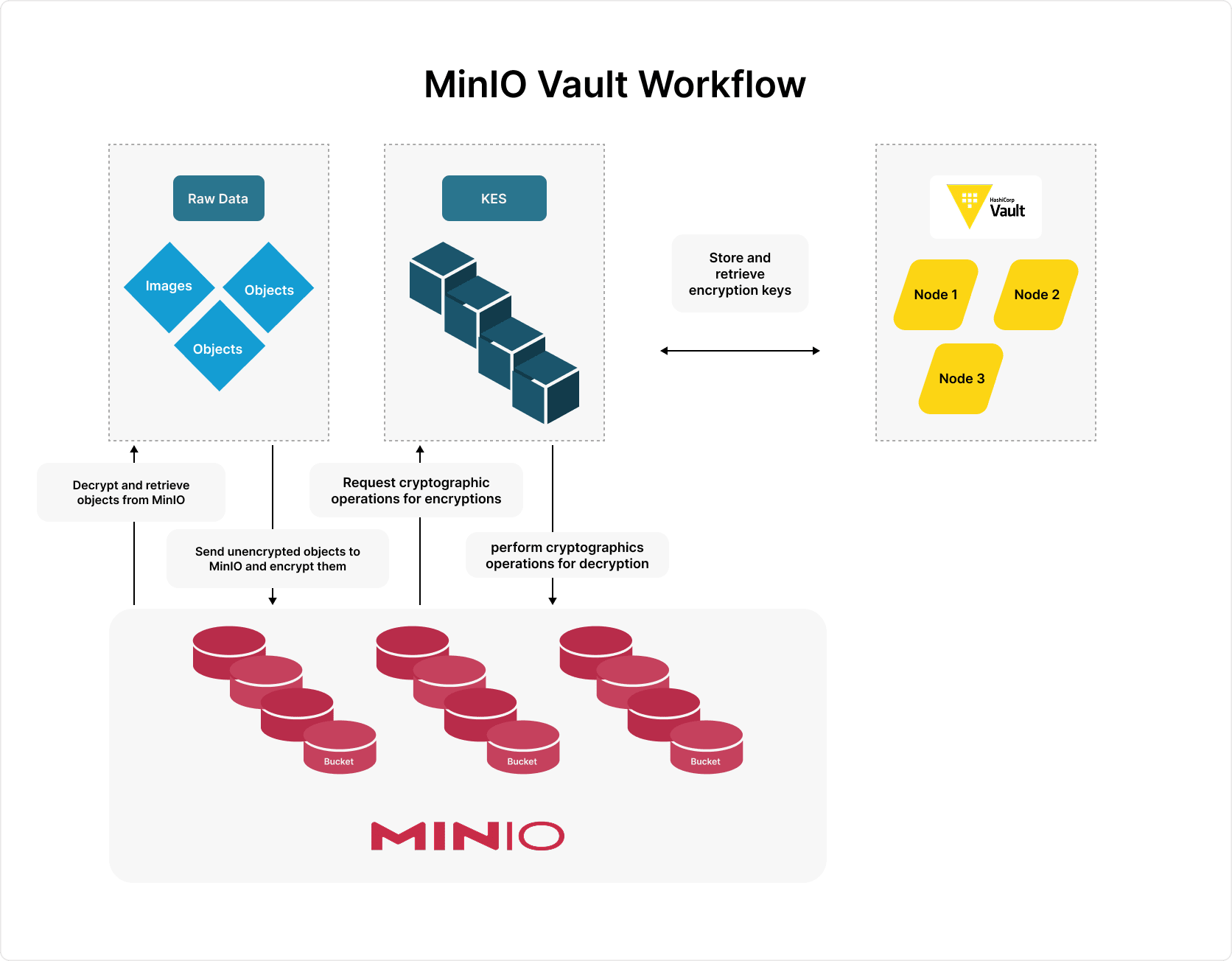Project Name
Securing Object Storage with MinIO Server-Side Encryption and HashiCorp Vault

![]()

Our client was running a multinational enterprise in the financial services sector, known for its rapid expansion and innovative approach to digital banking and financial technology. Operating across several regions, they need to handle large volumes of highly sensitive data, including Call Detail Records (CDRs), customer identity documents, transaction histories, and proprietary business reports. With strict adherence to data privacy and protection regulations such as GDPR, PCI-DSS, and HIPAA, the client required a robust, scalable, and compliant encryption mechanism for its object storage infrastructure.
Despite having an efficient MinIO-based object storage system, the client encountered several pressing challenges:
- Data Security Compliance: Meeting stringent regulatory standards while ensuring all stored data remains protected through encryption.
- Lack of Centralized Key Management: Encryption keys were managed locally, creating security vulnerabilities and operational risks due to potential key loss or compromise.
- Performance Overhead:The team needed an encryption mechanism that would not slow down data access or degrade overall system performance.
- Scalability: With rapidly growing data volumes, the solution had to be future-proof and capable of scaling without significant architectural changes.
To address these challenges, we implemented a server-side encryption solution using MinIO, Key Encryption Service (KES), and HashiCorp Vault as part of a modernized security architecture. This architecture effectively secures data at rest, ensuring compliance with regulatory requirements while maintaining performance efficiency.
1. The Redesigned Architecture
- Raw Data Ingestion: Images, videos, and other unstructured data objects are ingested and sent directly to MinIO for storage.
- MinIO Storage & Encryption: MinIO receives the unencrypted data and delegates encryption tasks to the Key Encryption Service (KES).
- Key Encryption Service (KES): KES acts as the encryption engine, handling all cryptographic operations on behalf of MinIO.
- Centralized Key Management with HashiCorp Vault: KES securely retrieves and manages encryption keys from HashiCorp Vault, ensuring centralized and secure key governance.
- Secure Decryption Process: Upon user request, MinIO coordinates with KES and Vault to decrypt objects on the fly, ensuring data is accessed securely and efficiently.
2. Implementation Steps
Infrastructure Setup:
- Deployed MinIO on high-performance storage nodes.
- Installed and configured HashiCorp Vault on a three-node cluster for high availability.
- Set up KES as the intermediary encryption service.
Key Management Configuration:
- Integrated HashiCorp Vault with KES to manage encryption keys securely.
- Configured MinIO to request cryptographic operations from KES.
Encryption Policy Enforcement:
- Enabled automatic server-side encryption on MinIO buckets.
- Applied encryption policies to enforce secure data storage.
Testing and Validation:
- Conducted encryption and decryption tests to validate data security.
- Measured system performance to ensure minimal latency impact.
Deployment and Monitoring:
- Rolled out the new architecture in production.
- Implemented monitoring tools to track encryption processes and key usage.
The newly implemented architecture delivered immediate and measurable benefits:
- Enhanced Data Security: All stored objects are now encrypted by default, significantly reducing the risk of data exposure.
- Regulatory Compliance: The setup aligns with GDPR, PCI-DSS, and HIPAA mandates for encrypted storage.
- Centralized Key Management: Encryption keys are securely stored and managed in HashiCorp Vault, minimizing the risk of exposure, unauthorized access, or loss.
- Minimal Performance Overhead: The encryption workflow is optimized for efficiency, ensuring secure data access with negligible impact on latency or performance.
- Scalability for Growth: The modular architecture ensures easy scalability to support future data growth without re-engineering.

By implementing server-side encryption using MinIO, KES, and HashiCorp Vault, the client successfully transformed its object storage security while maintaining performance and scalability. The solution reinforced data compliance, centralized key governance, and future readiness—all critical for a modern financial services enterprise.Further, the client plans to enhance its encryption framework with advanced audit logging and real-time monitoring to ensure continuous compliance and security intelligence across its data infrastructure.
Strengthen Your Data Protection Strategy with Ksolves Expertise!



